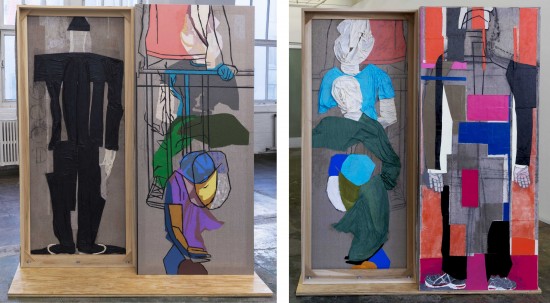
Dona Nelson is showing new paintings at Thomas Erben Gallery. There is no other artist in America that is a "modern painter" in so many different ways without losing her centre.
Trying to subvert its meaning seems to be part of the definition of what modern art is. There doesn't seem to be an accurate way to define an activity that is made up of a system or interelating systems that has occasional contradictions built into it, But art doesn't seem the worse for it. Modern painting in particular is like a series of interconnected temples where people are constantly entering and trying to knock down a load bearing pillar to see if it still stands or if it's now something else. It's quite often a sign that that particular approach is thriving.
Part of art's character is breaking its own rules but 20th Century Iconoclasm broke unsatisfactorily, missing bits, abandoning rich seams because no one wanted to be there at that point. Miss Nelson goes back to the old territory to make new proposals from the residue.
There are figures in the new work. Leisurely, sitting in the studio, or park, on the bus perhaps. One looks like a Rodchenko avatar simplified into "machine age" blocks but with Ben Shahn hands and sneakers. Right next to Magritte-like shrouded lovers' heads, formed in soaked and hardened muslin. All allusions lightly referred to though, so as not to disrupt the everyday atmosphere of her collection of people.
The paintings remind me of how early Modernist figures were pushed towards Abstraction via caricature and deconstruction. Picasso often treated them as if, succumbing to a stylistic collapse of the optical bottom line was a kind of torture. DN's figures merge into Abstraction but without an heroic, agonized, or hyper-erotic spirit. Although reminders of that under-content are still present.
The title of Miss Nelson's show "Models Stand Close to the Paintings" harkens back to a 1951 Vogue shoot by Cecil Beaton. I don't know whether, when Pollock saw the photographs of fashion models parked next to his paintings, that he thought it made his canvases look like high end decoration or if this was part of what galvanized him to paint the Black Series, where he stepped away from drip painting into a half-way place where his splashes merged with figures, birds and symbols. Dona Nelson refers to both Beaton's photographs where the figures also, just stand and sit. And at the same time to the Black paintings only using different kinds of mimesis to fuse abstraction and figuration together.
There are many ways to get there. In interviews, she talks about painting over one thing, pouring over another. Setting off in one direction, abandoning it and watching something else reveal itself. Dona Nelson's work has not been a meditation on formal constructs, or an idea of an absolute means of expression, but much more of an attempt to step outside of human programming. The studio is where presets and preconceptions are altered by testing and readjusting.
I suppose all modern artists do that but the difference is that she is not afraid to let you look in and see the joists holding up beams and half done sheet rock walls.
Around the room in deep, cupboard-shelf like stretchers, images are painted and formed on both sides of the canvas. Perhaps eventually these constructions will become whole rooms or houses. Perhaps she's going even further back than the beginning of Modernism -- to the idea of painted vessels and icon holders. Sometimes the paintings are bolted to a base, set at a slight angle to one another. I was told that they were fixed like that beforehand and she would have to figure out a way to work on the backs of the pieces, in the constricted space.
These are high places. Painting this high, let's you see for miles.
It's where Poetry and Philosophy meet. As well as a song of modern painting in all its parts.
It's about stepping outside of desire. Finding a way to let what's valuable speak for itself. - Millree Hughes
